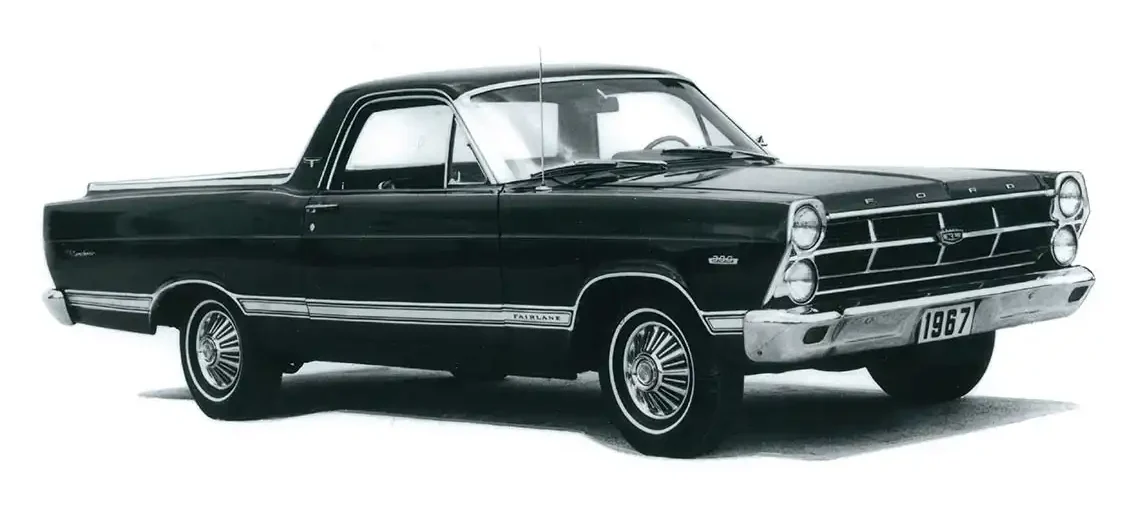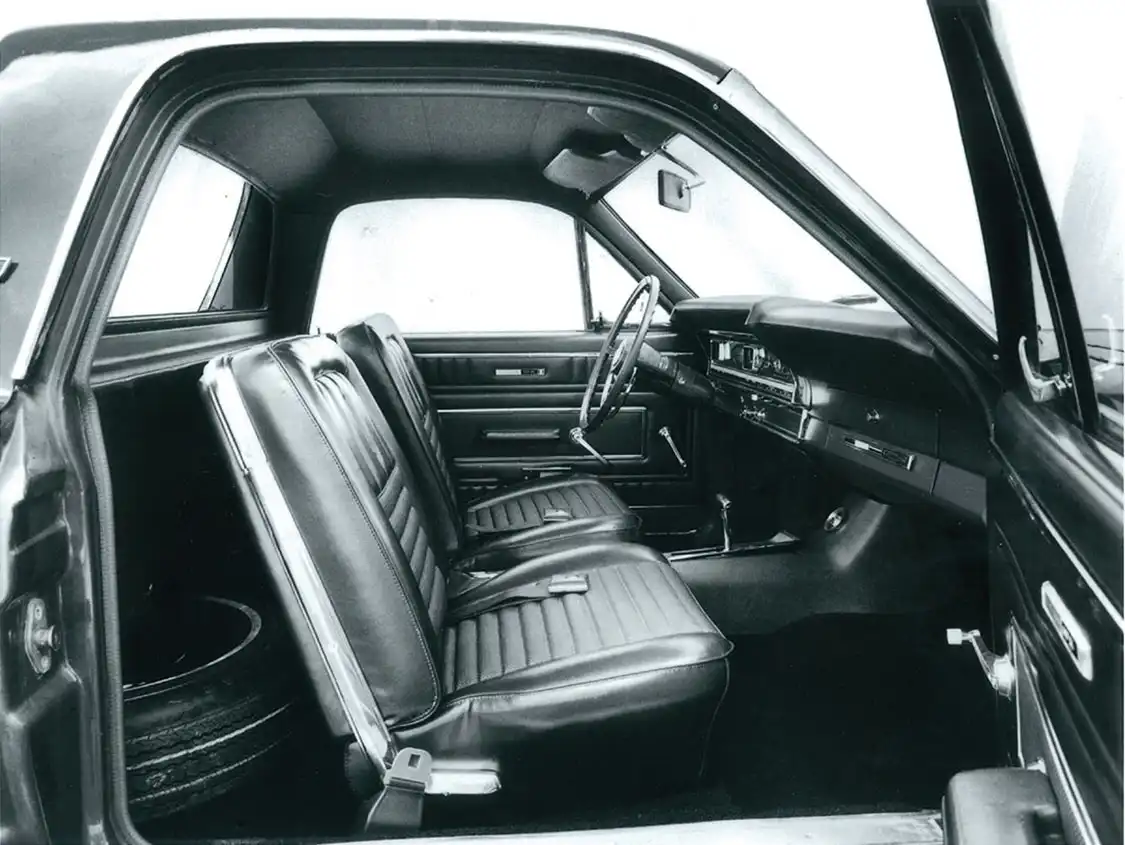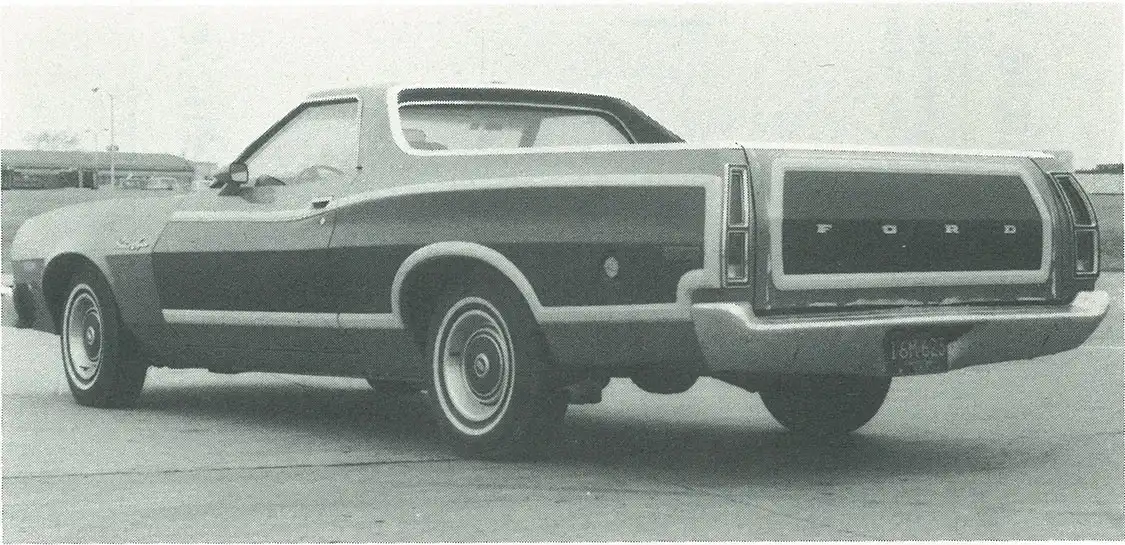 Bill Senefsky
.
April 26, 2023
.
All Feature Vehicles
Bill Senefsky
.
April 26, 2023
.
All Feature Vehicles

Ford Motor Company had reinvented itself during the immediate postwar era and entering into the 1950s. A fresh look was undertaken especially with regard to modern styling and new ideas regarding automotive platforms. Gone were the days of strict utility work platforms assembled from pieces supplied by aftermarket vendors to convert passenger car platforms into truck usage. In North America, pickup trucks were now designed from the ground up with distinct personality, workload capacities and overall dimensions. The mechanicals were also geared directly for work and transport applications.


Ninety days after the company’s traditional new vehicle launch in December 1956, Fords Ranchero hit the marketplace. Ford’s 2-door, short-wheelbase Ranch Wagon/Courier was the platform for this highly stylish idea. This new and novel vehicle was based on a production full-size station wagon platform, which featured stunning new lines for 1957. In tandem, a new Courier (panel delivery) version was also produced, though this series was a carryover.
The new Ranchero featured a structurally reinforced open bed along with its own uniquely designed rear window. Viewed from the side, the platform also featured an integrated cab and cargo box unit for a smoother silhouette. Although produced on an automotive assembly line, the Ranchero was directed toward and sold through the company’s truck division. In keeping with that tradition, the new platform was offered in just two trim options, the basic standard and the Custom. The latter deluxe version offered a variety of optional equipment taken off the shelf from its automotive cousin, the full-size Fairlane. The Custom versions featured a specialized “Longhorn” symbol located on the rear tailgate. Two-tone paint and stainless body moldings rounded out many optional packages.
Mechanically, the new platform was offered with Ford’s engine program from straight-6s to the 352 cu.-in. “Thunderbird Special” V-8 delivering 300 hp. The company included as a carryover its optional safety equipment from 1956, the deep-dish steering wheel, seat belts, padded dashboards and safety door locks. A Canadian version was also offered under the Meteor passenger car lineup.
The Ranchero was considered an immediate hit with the buying public, creating a niche market and utilizing a Southwestern marketing campaign to bolster sales.
The Ranchero was considered an immediate hit with the buying public, creating a niche market and utilizing a Southwestern marketing campaign to bolster sales. The utility of a pickup, combined with the ease of operation like a car found favor with many new prospects. With regard to load capacity, the stylish 116-in. wheelbase Ranchero platform could carry 50 lb. more than the company’s base full-size half-ton F100 pickup.
Continuing their successful trend, 1958 versions were an obvious carryover with refreshed front sheet metal shared with the full-size Fords. Dual headlights combined with a massive new front grille and increased side trim spotlighted the changes. Ranchero thus was included in Fords Thunderbird styling cue campaign.
For 1959, Ranchero customers were happy to note that another re-skinned version now sported a longer 7-ft. bed. This was due to the fact that 1959 full-size Ford’s now ran on a 118-in. wheelbase. The sheet metal again was shared allowing for an increased windshield area. Interior trim featured either vinyl or material called “woven plastic.” The full-size spare tire also was moved behind the passenger side front seat. This year’s platform was offered only in the Custom Ranchero version. The paint options were greatly expanded, now including 11 solids, 11 two-tones (white on top) and four two-tone choices.
A new decade had arrived and with it, massive changes in the auto industry. With economy in the air and the American automakers launching their new compacts to enter this new market niche, the Ranchero now appeared on a radically downsized 109.9-in. (70-in. width) Falcon platform. After all, recession vibrations were in the air and the import craze was just beginning. VW and Chevrolet’s new Corvair had also launched their radical and slightly “off-beat” rear-engine pickup and van platforms. Ford engineers felt that a new lighter conventional platform was the answer.


Now dubbed the Falcon Ranchero, the car took its mechanical components from its compact cousin being powered by a new 144-cu.-in. inline-6. A three-on-the-tree column shift was standard, with an optional 2-speed Ford-O-Matic available. Within a year, a 3-speed Cruise-O-Matic option would also be offered. The new Ranchero compact platform now had a reduced load capacity of just 800 lb. Horsepower had also become an issue, so the 170 cu.-in. inline-6 was offered in 1961. V-8 engines did not return until 1963’s launch of the company’s “thin-wall” 260- cu.-in. V-8 engine.
Ranchero body styling mirrored its Falcon cousin through the 1965 model year. Changes for 1965 thankfully included the larger 289-cu.-in. mill, replacing the 260. Company uniformity added an alternator as well. This was also the last year for the Sedan Delivery Panel platform.

For 1966, the Ranchero was offered on the new mid-size Fairlane platform. The automotive Falcon also grew in size, they shared the same chassis, and thus Ranchero shared Falcon’s front-end clip, grille, trim and interior pieces. True to its original heritage, Ranchero was again produced on a modified station wagon platform. Engine choices included the 170-cu.-in. inline-6, a 200-cu.-in. inline-6 and two versions of the 289-cu.-in. V-8, with either a 2- or 4-barrel carb. The 3-speed column shift again was standard with the C4 3-speed automatic listed as optional. For 1966, the platform was now marketed as the Ford Ranchero.
The new platform again became larger, in fact, returning to its past sizing from 1959. Stylewise, the platform displayed a more rounded look, with the flat-sided surfaces of its forerunner abandoned.

The platform was uniquely modified again for 1967. A new chassis utilized the 1966 Ranchero body with Fairlane styling, body components, sheet metal and trim. Offered for one year, the new look was widely popular and leaned heavily on performance themes now favored by the industry. Engine availability now included the standard 170- and 200-cu.-in. inliners, the 289 V-8, and for the first time, a 390 FE V-8 developing 315 hp. A new C6 3-speed automatic was optionally available for the big-block. The 3-speed manual remained standard fare. During this period of expanded options, the new 113-in. wheelbase Fairlane Ranchero was available in base, Ranchero 500, 500XL and GT.
In keeping with new Federal Safety mandates, Rancheros were now equipped with dual-master braking systems, padded interior windshield pillars and safety steering columns.
The industry’s emphasis continued on the increased sales success of the mid-size market along with a performance emphasis. Ford added its new Torino platform on the automotive side and it seemed logical to expand these offerings to the Ranchero as well. The new platform again became larger, in fact, returning to its past sizing from 1959. Stylewise, the platform displayed a more rounded look, with the flat-sided surfaces of its forerunner abandoned. A new front-end design appeared with horizontal dual headlights anchoring a 1-piece aluminum grille assembly. The new platform again shared its interior pieces with its Torino/Fairlane cousins. An interior highlight was the inclusion of a 4-pod instrument panel. Sadly, these units contained the usual idiot lights and did not include classic instruments.
Again, three trim levels were offered: Ranchero (base), Ranchero 500 and Ranchero GT. Engine availability started with the 250 inline-6, a 289 V-8 with 2-barrel carb and the venerable 390 FE big-block. The big news was the addition of Ford’s new 428-cu.-in. 335-hp “Cobra-Jet” V-8 that was offered in mid-year 1968. This same year marked the elimination of the 289, being upgraded to 302 in 2-barrel form for 1969. The new 351 “Windsor” mill was also added in 1969 with either 2- or 4-barrel carb. Transmission choices added a modified Cruise-O-Matic for the Windsors, dubbed the FMX. The standard three-on-the-tree and 3-speed automatic were carryovers, but the other big news was the availability of a 4-speed floor-mounted manual.

The option list again was shared with the automotive platforms and included factory air, bucket seats, center console, AM/FM radio, power front-disc brakes and a vinyl top. The optional non-functional hood scoop was standard on the GT.
Changes for 1969 Ranchero platforms were minor. A modified 3-piece grille eliminated the earlier crossbar and the center Ford crest was eliminated. The optional GT front badge was moved to the right corner of the grille. Ranchero scripts were relocated to the front fenders from the rear quarter panels. Inside, the instrument panel was “tweaked” with the addition of brushed aluminum instruments with black numerals and an obvious cheaper 2-spoke steering wheel.
A special order Rio Grande package was available featuring modified trim and paint colors. Although classified as a Special Performance Vehicle, engine choices remained standard production fare. These platforms were not hot-sellers and Ford insiders claim fewer than 800 were produced.
Big changes were noted in Ford’s styling elements during the early 1970s. Bunkie Knudsen had been hired as company president, and he immediately brought over several members of his GM styling staff to make radical changes in all of Ford’s automotive lineup.
For 1970, Ranchero again carried over Torino styling, but the platform had a totally new look and appearance. The coke-bottle silhouette returned, giving the platform a longer and lower stance, the Ranchero also looked wider. A shark-like recessed front grille utilized a mini-square grille pattern. Front fender lines were definitely accented. The company’s high-performance options were carried over as well with the inclusion of the 429 Cobra and Super Cobra mills added at the high end. The “shaker” hood scoop was also on the option sheet. Hide-away headlights were another styling option as was a Ranchero Squire option borrowed for Ford’s Country Squire wagon series. Most of the Torino option list was a carryover as well, and for the first time ever, the Ranchero had its own designated interior badging. In 1971, the platform sported a new 2-piece front grille.

Massive government safety intervention hit the market squarely during these years and the Torino/Ranchero platforms certainly were no exception. Massive bulk now displayed itself prominently in the front-end designs. A heavier grille cavity replaced the previous narrower editions. Front dual headlights were again separated from the grille assembly. The new look was certainly more aggressive and created a love-or-hate relationship with buyers of both series. Although three series were offered, the paper chase now designated a base 500, a wood-grained equipped Squire and the GT. Ranchero also returned to body-on-frame construction, riding on a 118-in. wheelbase.
Big changes were noted in Ford’s styling elements during the early 1970s. Bunkie Knudsen had been hired as company president, and he immediately brought over several members of his GM styling staff to make radical changes in all of Ford’s automotive lineup.

Engine availability remained flexible beginning with the 250 inline-6 while 8-cylinder options included the 302 V-8, Cleveland and Windsor 351 engines, and the big-block 429 Blue Crescent V-8 in 1972–1973. 1972 saw the launch of the new 400 V-8 emissions motor, a sign of things to come. A hotter version of the 351 was also offered. Dubbed the Cleveland Cobra-Jet, it was offered until 1974. A 460-cu.-in. version of the 429 was in the paperwork for 1974–1976. Floor-mounted 4-speed manual transmissions continued to be offered on GT and Cobra-Jet powered platforms. The biggest news regarding these mills was the lack of horsepower due to severe emissions standards along with a lower compression head design.
Government-mandated front and rear bumper protection caused another front-end redesign in 1973. This last design effort remained until 1976 with the Torino platform’s demise. A variety of color and tape trim treatments remained until the end of this series.
The Ranchero platform was changed completely once more in 1977. This time out the unit was enlarged again to 220.1-in. overall length. The new version now shared its platform with Ford’s new and larger Thunderbird. Styling influences and sheet metal shared components with the new LTD II. All three automotive platforms obviously featured a return to the long hood design that the company enjoyed with earlier models. The rounded side appearance also featured less chrome. Three model and trim packages returned with the usual number of interior options and features. Engine choice was now severely limited, with the largest offering being the 400 V-8. Ranchero production ceased in 1979, although a final commemorative version was offered as a 1979½ offering. This offering featured a leather interior and dashboard, special exterior paint color and trim.
Government-mandated front and rear bumper protection caused another front-end redesign in 1973.

It can be noted that this highly popular and unique vehicle sold slightly over 500,000 units over its history. Ford claims that changing market tastes and the emergence of downsized platforms affected future sales goals. That argument is weak because when one looks back, it can be factually noted that the Ranchero series had shared almost every platform the company ever produced in one shape or other. Ranchero platforms remain highly popular today with a variety of collectors.
We use cookies to enhance your browsing experience, serve personalized ads or content, and analyze our traffic. By clicking "Accept All", you consent to our use of cookies. Visit our Cookie Policy for more info.
Notifications
Share Link